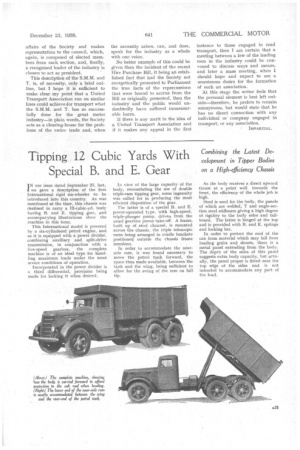Tipping 12 Cubic Yards With Special B. and E. Gear
Page 33

If you've noticed an error in this article please click here to report it so we can fix it.
Combining the Latest Development in Tipper Bodies on a High-efficiency Chassis I N our issue dated September 23, last, we gave a description of the first International rigid six-wheeler to be introduced into this country. As was mentioned at the time, this chassis was destined to carry a 12-cubic-yd. body having 13. and E. tipping gear, and accomparying illustrations show the machine in this form.
This International model is powered by a six-cylindered petrol engine, and as it is equipped with a power divider, combining auxiliary and split-drive transmission, in conjunction with a five-speed gearbox, the complete machine is of an ideal type for handling maximum loads under the most severe conditions of operation.
Incorporated in the power divider is a third differential, provision being made for locking it when desired.
In view of the large capacity of the body, necessitating the use of double triple-ram tipping gear, some ingenuity was called for in producing the most efficient disposition of the gear.
The latter is of a special B. and E. power-operated type, with high-speed, triple-plunger pump, driven from the usual gearbox power take-off. A frame, built up of steel channel, is mounted across the chassis, the triple telescopic rams being arranged in cradle brackets positioned outside the chassis frame members.
In order to accommodate the nearside ram, it was found necessary to move the petrol tank forward, the space thus made available, between the tank and the wing, being sufficient to allow for the swing of the ram on full tip. As the body receives a direct upward thrust at a point well towards the front, the efficiency of the whole job is high.
Steel is used for the body, the panels of which are welded, T and angle-section steel stiffeners giving a high degree of rigidity to the body sides and tailboard. The latter is hinged at the top and is provided with B. and E. springs and locking bar.
In order to protect the roof, of the cab from material which may fall from loading grabs and shoots, there is a metal panel extending from the body. The depth of the sides of this panel suggests extra body capacity, but actually, the panel proper is fitted near the top edge of the sides and is not intended to accommodate any part of the load.




































































